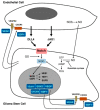Cancer Stem Cells: Significance in Origin, Pathogenesis and Treatment of Glioblastoma
- PMID: 33799798
- PMCID: PMC8000844
- DOI: 10.3390/cells10030621
Cancer Stem Cells: Significance in Origin, Pathogenesis and Treatment of Glioblastoma
Abstract
Cancer stem cells (CSCs), known also as tumor-initiating cells, are quiescent, pluripotent, self-renewing neoplastic cells that were first identified in hematologic tumors and soon after in solid malignancies. CSCs have attracted remarkable research interest due to their role in tumor resistance to chemotherapy and radiation treatment as well as recurrence. Extensive research has been devoted to the role of CSCs in glioblastoma multiforme (GBM), the most common primary brain tumor in adults, which is characterized by a dismal prognosis because of its aggressive course and poor response to treatment. The aim of the current paper is to provide an overview of current knowledge on the role of cancer stem cells in the pathogenesis and treatment resistance of glioblastoma. The six regulatory mechanisms of glioma stem cells (GSCs)-tumor microenvironment, niche concept, metabolism, immunity, genetics, and epigenetics-are reviewed. The molecular markers used to identify GSCs are described. The role of GSCs in the treatment resistance of glioblastoma is reviewed, along with future treatment options targeting GSCs. Stem cells of glioblastoma thus represent both a driving mechanism of major treatment difficulties and a possible target for more effective future approaches.
Keywords: cancer; cancer stem cells; glioblastoma; glioma; glioma stem cells.
Conflict of interest statement
The authors declare no conflict of interest.
Figures




References
-
- Forjaz G., Sloan B.J.S., Kruchko C., Siegel R., Negoita S., Ostrom Q.T., Dickie L., Ruhl J., Van Dyke A., Patil N., et al. An updated histology recode for the analysis of primary malignant and nonmalignant brain and other central nervous system tumors in the Surveillance, Epidemiology, and End Results Program. Neuro-Oncol. Adv. 2021;3:175. doi: 10.1093/noajnl/vdaa175. - DOI - PMC - PubMed
Publication types
MeSH terms
Substances
LinkOut - more resources
Full Text Sources
Other Literature Sources
Medical

